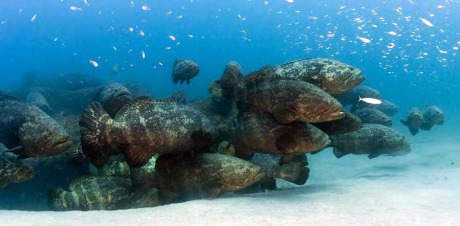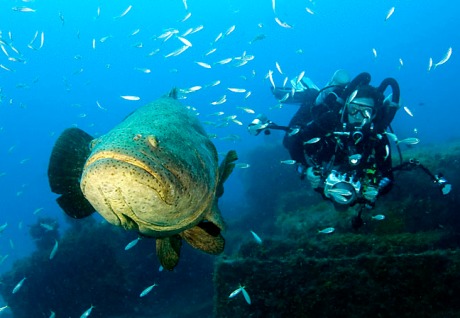The Diving Equipment and Marketing Association (DEMA), is the international trade association for the recreational scuba diving and snorkeling industry. DEMA supports the continued protection of Goliath Groupers in Florida.
Tom Ingram, DEMA President and CEO, recently wrote a letter to the Florida Fish and Wildlife Conservation Commission (FWC) regarding their proposal that, if approved, would allow killing the critically endangered Goliath Grouper.
You can attend the FWC workshops, write emails to the FWC Commissioners (commissioners@MyFWC.com), call (850-487-0554) or post your comments here
Today, Tom Ingram is my guest blogger. Here is the letter he sent to FWC, copied to Rick Scott, Florida Governor, Nick Wiley, FWC Executive Director, Bob L. Harris, Esq., attorney in Tallahassee and the DEMA Board of Directors.
August 8, 2017
From: Tom Ingram, President and CEO Diving Equipment and Marketing Association 3750 Convoy Street Suite 310, San Diego, CA 92111
To: Chairman Brian Yablonski Florida Fish and Wildlife Conservation Commission Farris Bryant Building 620 S. Meridian St., Tallahassee, FL 32399
Dear Commissioner Yablonski:
Having reviewed the “Goliath Grouper Review and Discussion” produced by the Florida Fish and Wildlife Commission (FWC) for presentation on February 8, 2017, as well as for Goliath Grouper Workshops slated for August through October 2017, I am writing to express our concerns regarding the possible lifting of the current moratorium on harvesting these animals.
The Diving Equipment and Marketing Association (DEMA) is the international trade association for the recreational scuba diving and snorkeling industry. DEMA has more than 1,400 business members worldwide, and represents the interests of diving manufacturers, diver training organizations, the diving-related magazines and media, diving retailers and dive travel and dive charter operators. DEMA’s mission is to bring businesses together to grow the diving industry worldwide, and our goals include promoting recreational scuba diving and snorkeling, while protecting the underwater environment.
DEMA is aware of the lead role FWC took in the 2013-2016 stock assessment conducted by the Joint Ad Hoc Council Goliath Grouper Committee. We applaud the FWC for this effort, and we support such periodic stock assessments when they include sound scientific inquiry and input from all user groups affected by any change in the current harvesting status.
As you know, in 2016 the results of this Council’s assessment were rejected by a group of independent scientists for use in management of the stocks of goliath grouper in federal waters, pointing to the fact that, “the results were not deemed suitable primarily because of missing information needed to generate an accurate ‘model’ of the fishery.”
The many challenges to assessing this species, as outlined on February 8, 2017, FWC presentation, point to the need for further study prior to opening this species to a harvest of any kind. Therefore, DEMA favors the following:
1. Maintaining the current harvesting status of the goliath grouper in Florida; that is, harvest and possession should be prohibited.
2. FWC or NOAA (or another appropriate agency or scientific organization) should undertake a more thorough stock assessment of the goliath grouper that satisfies the need for accurate scientific data on stocks of these fish.
3. FWC or NOAA (or another appropriate agency or scientific organization) should conduct additional research on the age of these creatures, such that any future assessment would have more validity.
4. FWC should review its current regulations to determine if protections for goliath grouper could be implemented commensurate with protections afforded to manatees.
DEMA’s position is taken in recognition of FWC’s own list of assessment challenges and the 2016 conclusion that information needed to generate an accurate model of the fishery was missing. Without solid scientific evidence of recovery, it appears that the goliath grouper remains vulnerable to overfishing due to (among several reasons) late maturity, slow growth and is subject to large scale mortality.
As the Commission is also aware, over the last twenty-seven years during which harvesting was prohibited, goliath grouper have become extremely popular hosts to underwater habitats and are mentioned frequently by visiting/tourist divers who greatly enjoy watching these remarkable creatures roam the ocean floor. The goliath grouper’s size, visibility, low birth rate and slow movement seem to trace another of Florida’s truly majestic waterborne creatures, the manatee, a protected species that also has considerable ecotourism value. If harvesting is allowed without verified stock assessments, goliath grouper could easily be thrown back to species extinction.

Goliath Grouper spawning aggregation. SCUBA divers from all over Florida, the USA and the world pay to dive with these gentle giants in Florida. Photo credit: W. Stearns
In addition to concern regarding the stocks of these fish, DEMA also relies on the opinions of divers and dive-related businesses regarding the current harvesting status of goliath grouper. In a July 2017 DEMA survey of divers and dive professionals, more than 69% indicated their desire to maintain the current moratorium on harvesting the goliath grouper. Among those located in Florida, 64% indicated a desire to maintain the moratorium, while among those traveling to Florida to dive and see the goliath grouper while diving (bringing tourist and tax revenue to the state) the number rose to more than 77%.
With the results of studies included in FWC’s February 8, 2017 presentation indicating high levels of mercury in the flesh of goliath grouper, and with a high economic value among divers, especially those from outside of Florida who are willing to pay $336.00 to see these fish (as compared to a maximum of $79 for fishers to harvest a goliath grouper), it seems most appropriate economically and scientifically to maintain the moratorium on the goliath grouper harvest.
DEMA strongly recommends maintaining the current prohibition on harvesting the goliath grouper.
Thank you for your careful consideration of this issue.
Sincerely,
Tom Ingram President and CEO
cc: Governor Rick Scott
Nick Wiley, Executive Director, Florida Fish & Wildlife Conservation Commission
Bob L. Harris, Esq., Tallahassee
DEMA Board of Directors




